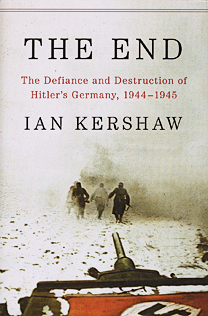REVIEW: The End: The Defiance and Destruction of Hitler’s Germany, 1944-1945
Book by Ian Kershaw
Share
 On April 18, 1945, with American troops outside the defenceless German town of Ansbach, a 19-year-old theology student tried to force the town’s surrender by severing the phone lines between the commandant and the nearest Wehrmacht unit. Caught and subjected to a “trial” lasting minutes, Robert Limpert was hanged in the town square by order of the Nazi commandant. Soon after, he requisitioned a bicycle and fled. Four hours later the Americans entered without a shot fired, and cut down Limpert’s body.
On April 18, 1945, with American troops outside the defenceless German town of Ansbach, a 19-year-old theology student tried to force the town’s surrender by severing the phone lines between the commandant and the nearest Wehrmacht unit. Caught and subjected to a “trial” lasting minutes, Robert Limpert was hanged in the town square by order of the Nazi commandant. Soon after, he requisitioned a bicycle and fled. Four hours later the Americans entered without a shot fired, and cut down Limpert’s body.
Many people—certainly the German officers who tried to assassinate Hitler on July 20, 1944—knew the Third Reich was effectively dead months before Limpert. Its ongoing refusal to admit it, a refusal that led to the deaths of millions, far more of them Germans than in the war’s earlier years, is for Kershaw a puzzle. Taking the Ansbach incident—just one pointless death out of the war’s 50 million—as a symbolic starting point, the historian asks what within Nazi Germany explains the nation’s self-destruction.
To answer that Hitler would not surrender simply raises another question, Kershaw argues: why was anyone still listening to him? The Allied demand for unconditional surrender on all fronts kept the Wehrmacht fighting, terrified of Soviet invasion—and rightly so, given its own record in Russia. (That was the unspoken subject of Berliners’ black joke in 1945, “Enjoy the war, the peace will be much worse.”) And the Nazi party intensified its repression, cracking down savagely on any hint of opposition. By early 1945 most Germans still saw no way out.
The true irony of the Third Reich’s apocalyptic implosion is one Kershaw does not touch on, since it belongs to the war’s aftermath. Nations that surrender before all is lost tend to maintain a continuation in their traditions—just as a militaristically inclined Germany did in 1918. But in the Götterdämmerung of 1945, the nation lost, seemingly forever, the strains of nationalism, murderous idealism and imperial designs that had started two world wars.